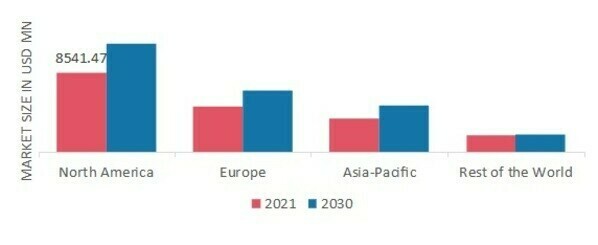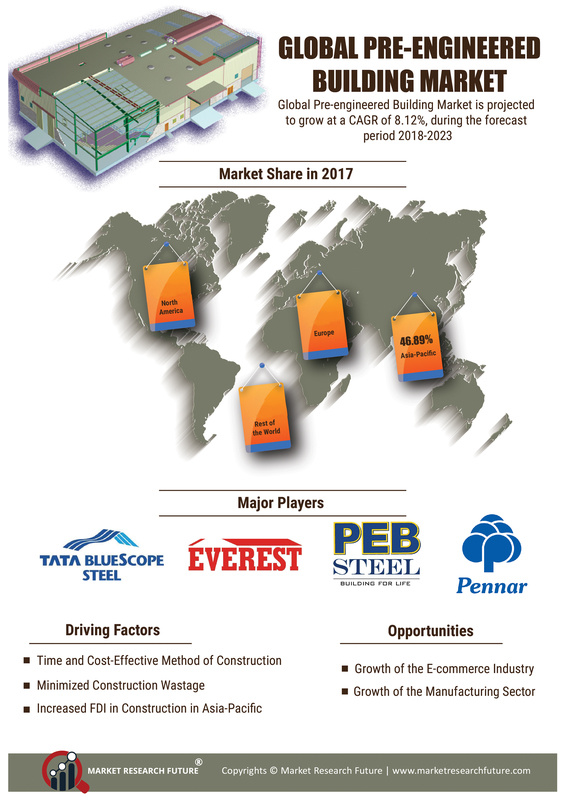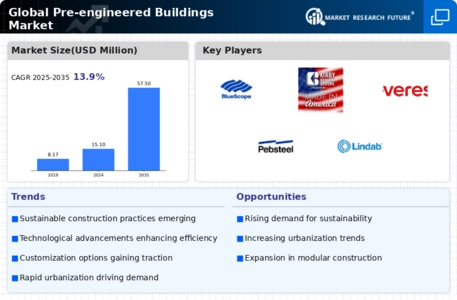
プレエンジニアードビル市場 トレンド
倉庫の需要増加がプレエンジニアードビル市場の成長を促進
プレエンジニアードビル業界は、世界中の産業化の進展と先進的なオフサイト建設方法および技術への認識の高まりにより拡大しています。小売業界では、電子商取引や物流ストアの増加に伴い、産業用ストレージ施設や倉庫の需要が急増しています。従来の建物よりも手頃で耐久性のあるプレエンジニアードビルは、今やより必要とされています。プレエンジニアードビルシステムの主な性能上の利点には、建材のライフサイクルの長さ、無限のデザインの自由、そして低い材料および労働コストが含まれます。プレエンジニアードグリーンビルの登場により、市場は成長しています。
これらのエコフレンドリーな建物は、建設中および建設後に必要な炭素排出量が少ないエネルギー効率の高い選択肢です。
さらに、プレエンジニアード構造物と技術の進歩は、生活の質を大幅に向上させました。 masonryと比較して、プレエンジニアードビルの建設には30%から40%少ない時間がかかります。インドのような熱帯国では、PEBビルの効果的な断熱が大いに役立ちます。遠隔地や傾斜地での建設には、プレエンジニアードビルが優れた選択肢です。最近の金属建築協会(MBA)の調査によると、プレエンジニアード構造物はアメリカの非住宅低層建物の60%以上を占めています。したがって、倉庫の需要の急増と技術の進歩が、近年のプレエンジニアードビル市場のCAGRを高めています。
さらに、プレエンジニアードビル市場の収益は、予測期間中に腐食リスクの増加や熱および耐火性の低下により制約されると予想されています。インドのような国でプレエンジニアードビルを採用する上での大きな障壁は、従来の建設技術への持続的な依存です。しかし、予測期間中には、プレエンジニアードビルの利点に対する認識が高まるにつれて、これらの製品の需要が大幅に増加すると予想されています。
プレエンジニアードビル市場 運転手
市場成長予測
グローバルプレエンジニアードビルディング市場は、今後数年間で堅調な成長を遂げると予測されています。2024年には151億米ドルの市場評価が見込まれ、2035年には575億米ドルに達することが予想されています。この成長軌道は、2025年から2035年までの間に年平均成長率12.96%を示しており、さまざまなセクターでの強い需要を反映しています。この拡大に寄与する要因には、都市化の進展、技術革新、持続可能な建設慣行への重視の高まりが含まれます。市場の潜在能力は、進化する業界のニーズや消費者の好みに適応する能力によって裏付けられています。
コスト効率と時間の節約
コスト効率は、グローバルプレエンジニアードビルディング市場の重要な推進要因です。プレエンジニアードビルディングは、従来の建設方法と比較して、通常、材料と労働力が少なくて済むため、 significantなコスト削減が実現します。さらに、これらの構造物に関連する迅速な建設スケジュールにより、開発者は市場機会をより迅速に活用できるようになります。この効率性は、商業不動産などの分野で特に魅力的であり、タイム・トゥ・マーケットが収益性に大きな影響を与える可能性があります。その結果、市場は substantialな成長が見込まれており、2024年には15.1億米ドルの評価が予測されています。これは、これらの経済的利点によって推進されています。
建設における技術の進歩
技術革新は、グローバルプレエンジニアードビルディング市場を再構築し、設計および建設プロセスを向上させています。高度なソフトウェアツールとビルディングインフォメーションモデリング(BIM)は、正確な計画と実行を促進し、エラーと建設時間を削減します。さらに、プレエンジニアードビルディングへのスマート技術の統合により、エネルギー管理と居住者の快適性が向上します。これらの技術が進化するにつれて、より多くの投資家や開発者を惹きつけ、市場をさらに拡大する可能性があります。2025年から2035年までの年平均成長率12.96%が予測されており、技術革新によって推進される成長の可能性を強調しています。
急速な都市化とインフラ開発
都市化は世界的に加速し続けており、インフラ開発のニーズが高まっています。グローバルプレエンジニアードビルディング市場は、このトレンドから恩恵を受けており、プレエンジニアードソリューションは迅速な組み立てとコスト効率を提供し、都市環境に最適です。インドやナイジェリアのような急速に人口が増加している国々は、住宅や商業目的でこれらの構造物をますます採用しています。この需要は、市場を2035年までに推定575億米ドルに押し上げると予想されています。緊急の住宅およびインフラニーズに効率的に対応できる能力は、プレエンジニアードビルディングを都市計画における実行可能なソリューションとして位置づけています。
産業全体にわたる多様な応用
プレエンジニアリング建物の多様性は、グローバルプレエンジニアリング建物市場の主要な推進要因です。これらの構造物は、農業、製造業、小売業など、さまざまな分野で利用されています。たとえば、農業施設は特定の運用ニーズに応じたカスタマイズ可能なデザインの恩恵を受け、小売スペースはプレエンジニアリングソリューションの美的柔軟性を活用しています。この適応性は、多様な顧客の要求に応えるだけでなく、市場浸透を高めます。産業がプレエンジニアリング建物の利点を認識し続ける中、市場は大幅に拡大することが予想され、2035年までに575億米ドルに達する可能性があります。
持続可能な建設に対する需要の増加
グローバルプレエンジニアードビルディング市場は、持続可能な建設ソリューションに対する需要が急増しています。環境問題が深刻化する中、建設業者や開発者はエネルギー効率が高く、廃棄物が削減されるプレエンジニアードビルディングをますます好むようになっています。例えば、これらの構造物はリサイクル可能な材料を利用することが多く、再生可能エネルギー源を取り入れるように設計することも可能です。この傾向は、カーボンフットプリントを削減することを目指した世界的な取り組みと一致しており、2024年には151億米ドルの市場評価につながる可能性があります。持続可能性への強調は、プレエンジニアードセクターにおける革新と採用を促進し、予測される成長軌道に寄与するでしょう。
市場セグメントの洞察
プレエンジニアリング建物の材料インサイト
プレエンジニアリング建物の市場セグメンテーションは、材料に基づいて鋼、アルミニウム、その他に分類されます。鋼セグメントは2021年に大部分のシェアを占め、プレエンジニアリング建物市場の収益に貢献しました。建設用の鋼をプレファブリケートすることには、建物の速度が50%向上すること、高い品質管理レベル、廃棄物の削減など、いくつかの利点があります。鋼は工場で加工できる材料であり、屋根の追加やその他の建物の改良に理想的です。
さらに、耐候性、湿気、シロアリ、火災に対する抵抗性などの特性は、耐久性、安全性、低コストのメンテナンスを提供し、世界のプレエンジニアリング建設業界における鋼材の需要を促進しています。
アルミニウムは、プレエンジニアリングビル市場のかなりのシェアを占める、第二の成長が最も早いセグメントです。プレエンジニアリング金属建物キットを使用することには、アルミニウム製造企業の規模や範囲に応じていくつかの利点があります。大規模で広がりのある多層の複雑な建物でも、小規模で単層の施設でも可能です。金属建物キットは、すべての要件を満たすことができます。
プレエンジニアードビルディング製品のインサイト
プレエンジニアリング建物の市場セグメンテーションは、製品に基づいており、壁、柱および梁、屋根および床、その他が含まれます。屋根および床のセグメントは2021年に大部分のシェアを占め、プレエンジニアリング建物の市場データに貢献しました。価値に関しては、床材と屋根は、世界中のプレエンジニアリング構造の重要な要素です。建物の屋根はその上部の覆いとして機能し、最も多くの太陽放射にさらされます。人間の活動がかける負担を支えるために、安全で安定している必要があります。屋根はまた、音と熱からの断熱が必要です。
さらに、床は建築の柔軟性とデザインの両方にとって重要な要素です。床の耐荷重能力は、PEBの間仕切り壁やその他の構造部材に直接影響を与えます。
壁は、プレエンジニアリングビル市場のかなりのシェアを占める、第二の成長が最も早いセグメントです。プレエンジニアリング部品で作られた構造物は適応性があります。洗練された仕上げのために、さまざまなファシアタイプ、キャノピー、ガラスパーティションなどでカスタマイズでき、優れた外観の構造物を作成できます。プレキャストコンクリートの壁パネル、カーテンウォール、ブロック壁、その他の壁システムは、曲がったひさしのような他の構造要素に取り付けることができます。
地域の洞察
地域別に、研究は北米、ヨーロッパ、アジア太平洋地域およびその他の地域に関する市場の洞察を提供します。アジア太平洋地域のプレエンジニアリング建物市場は、2021年に4217.9642百万米ドルを占め、研究期間中に39.80%のCAGR成長を示すと予想されています。これは、プレエンジニアリング建物の不動産業界の成長と、地域全体の企業環境の成長に起因しています。
予想される期間中、中国のプレエンジニアリング建物市場も国際市場プレーヤーにとって魅力的な機会を提供するでしょう。製造業への投資を促進する好意的な政府政策により、同国は予測期間中に工業用建物の増加が見込まれています。さらに、BMWやフォルクスワーゲンを含むさまざまな企業による生産施設の移転は、工業用建物の建設需要を高め、業界の成長を助けるでしょう。
さらに、市場報告書で調査された主要国は、アメリカ、カナダ、ドイツ、フランス、イギリス、イタリア、スペイン、中国、日本、インド、オーストラリア、韓国、ブラジルです。
図3: プレエンジニアリング建物市場シェア地域別 2021年 (%) 出典: 二次研究、一次研究、市場調査未来データベースおよびアナリストレビュー
出典: 二次研究、一次研究、市場調査未来データベースおよびアナリストレビュー
北米のプレエンジニアリング建物市場は、予測期間中に第二の大きなシェアを保持し、持続的に成長することが期待されています。不動産および商業セクターの修理および改修プロジェクトが、地域におけるプレエンジニアリング建物の需要を高めると予想されています。ブータンの国立住宅開発公社(NHDCL)によると、2025年までに1,018の手頃な価格の住宅が建設される予定です。1,018(123棟)の手頃な賃貸住宅ユニットの完成には2025年末までかかる見込みで、より手頃な住宅を早く望んでいた地元住民を失望させることになります。
多国籍企業は、現代のプレエンジニアリング建物技術のおかげで、プンツォリンとサムツェで建設契約を競うことができ、地元企業は必要な知識と人材を提供します。さらに、アメリカのプレエンジニアリング建物市場は支配的な地域であり、カナダのプレエンジニアリング建物市場は北米地域で最も成長が早い市場です。
中東諸国は、石油およびガスセクターへの依存を減らすために経済の多様化を追求しています。彼らは持続可能な経済成長のための長期計画を策定し、建設セクターにおけるプレエンジニアリング建物の概念を実施しています。さらに、MEAのプレエンジニアリング建物市場は、観光セクターの強力な成長から恩恵を受けると予測されています。
主要企業と競争の洞察
主要な市場プレーヤーは、製品ラインを強化するために多くの資本を研究開発に投資しており、これがプレエンジニアードビルディング市場の拡大を助けるでしょう。市場プレーヤーは、プレエンジニアードビルディング市場における新製品の革新や発売、契約や合意、合併・買収、より良い投資、他の組織との協力や戦略的パートナーシップなど、世界的な足跡を拡大するためのさまざまな戦略的措置を講じています。プレエンジニアードビルディング業界の競合他社は、ますます競争が激化し拡大する市場環境で生き残り、成長するために、コスト効果の高い商品を提供しなければなりません。
プレエンジニアードビルディング業界の製造業者が顧客に利益をもたらし、市場セクターを拡大するために採用する主要なビジネス戦略の一つは、運営コストを削減するために現地で製造することです。近年、プレエンジニアードビルディング業界は医療に対していくつかの重要な利益を提供してきました。プレエンジニアードビルディング市場の主要プレーヤーであるブルースコープ、ザミルスチールホールディングカンパニー、カービービルディングシステムズ、ヌコールコーポレーション、エベレストインダストリーズなどは、研究開発活動に多額の投資を行うことで市場の成長を促進しています。
ヌコールコーポレーションは、特殊金属建築システムの設計と製造において30年以上の経験を持っています。同社は、北米およびそれ以外の地域で、4つの戦略的に配置された工場と1,200以上の認定ビルダーの全国ネットワークを通じて顧客に効果的にサービスを提供しています。2022年12月、ヌコールコーポレーションは、最近設立されたヌコールタワー&ストラクチャーズ事業部が、2つの新しい最先端のタワー製造施設を建設することで拡大されると発表しました。ヌコールは、中西部と南東部の2つの地域を検討しています。
また、ザミルスチールホールディングカンパニーはプレエンジニアードビルディング会社です。ザミルスチールは、年間製造能力が6,000,000 m²を超えるアジアおよびアフリカのプレエンジニアードビルディングの最大の製造業者および供給業者の一つです。2021年11月、ザミルスチールビルディングエジプトの発表によると、1999年の設立以来、カイロの10月6日市とサダット市の工場で100万メトリックトンの鋼製品が生産されています。
プレエンジニアードビル市場市場の主要企業には以下が含まれます





業界の動向
- 2024年第2四半期:タタ・ブルースコープ・スチールがグジャラート州に新しいプレエンジニアードビルディング製造施設を開設 タタ・ブルースコープ・スチールは、インドのグジャラート州に最新鋭の製造工場を開設し、プレエンジニアードビルディングソリューションの生産能力を拡大し、地域の需要の高まりに応えました。
- 2024年第1四半期:バトラー・マニュファクチャリングがカナダの建設会社エリスドンとの戦略的パートナーシップを発表 バトラー・マニュファクチャリングは、エリスドンと提携し、北米全体で大規模なプレエンジニアードビルディングプロジェクトを共同で提供し、プロジェクトのタイムラインを短縮し、コスト効率を向上させることを目指します。
- 2024年第2四半期:リンダブがデンマークのプレエンジニアードビルディング専門企業プロフィルビュグを買収 リンダブグループは、デンマークに本社を置くプレエンジニアードスチールビルの製造業者プロフィルビュグを買収し、北欧の建設市場での地位を強化しました。
- 2024年第3四半期:キングスパン・グループが新しいエネルギー効率の高いプレエンジニアードビルディング製品ラインを発表 キングスパン・グループは、商業および産業クライアント向けに持続可能なソリューションを提供するために、先進的な断熱材と省エネルギー技術を備えた新しいプレエンジニアードビルディングのラインを発表しました。
- 2024年第2四半期:PEBスチールがベトナムの物流パーク開発のために5000万米ドルの契約を獲得 PEBスチールビルディング社は、ホーチミン市に新しい物流パークのためのプレエンジニアード倉庫を設計・建設する大規模な契約を獲得し、今年の地域での最大の取引の一つとなりました。
- 2025年第1四半期:ブルースコープ・スチールがグローバルなプレエンジニアードビルディングの拡大をリードする新CEOを任命 ブルースコープ・スチールは、ジャネ・スミスを新CEOに任命し、プレエンジニアードビルディング部門の国際的な成長を推進し、東南アジアへの新市場参入を監督する任務を与えました。
- 2025年第2四半期:ザミル・スチールがサウジアラビアの建設大手アル・バワニとのジョイントベンチャー契約を締結 ザミル・スチールは、サウジアラビアの産業および商業開発のために大規模なプレエンジニアードビルディングプロジェクトを提供するために、アル・バワニとのジョイントベンチャーを結成しました。
- 2024年第1四半期:ヌコールが米国市場向けの新しいモジュラー・プレエンジニアードビルディングシステムを発表 ヌコール社は、商業および産業用途向けに迅速な展開を目的としたモジュラー・プレエンジニアードビルディングシステムを導入し、建設時間とコストを削減することを目指します。
- 2024年第3四半期:カービー・ビルディング・システムズがエジプトに新しい製造施設を開設 カービー・ビルディング・システムズは、北アフリカおよび中東におけるプレエンジニアードビルディングの需要の高まりに応えるために、エジプトに新しい工場を開設しました。
- 2025年第2四半期:インターアーチがインドのプレエンジニアード学校建設のための政府契約を獲得 インターアーチ・ビルディング・プロダクツは、インドの複数の州でプレエンジニアード学校建物を供給・建設するための政府契約を受注し、迅速なインフラ開発を支援します。
- 2025年第1四半期:PEBスチールが先進的な建築技術のための新しい研究開発センターに3000万米ドルを投資すると発表 PEBスチールは、プレエンジニアードビルディングのための革新的な材料とデザインに焦点を当てた研究開発センターに3000万米ドルを投資する計画を発表しました。
- 2024年第2四半期:バトラー・マニュファクチャリングがテキサス州のアマゾン流通センターの契約を獲得 バトラー・マニュファクチャリングは、テキサス州にあるアマゾンの大規模なプレエンジニアード流通センターを設計・建設する契約を獲得し、電子商取引インフラにおけるこの分野の役割を強調しました。
今後の見通し
プレエンジニアードビル市場 今後の見通し
グローバルプレエンジニアードビルディング市場は、2024年から2035年までの間に12.96%のCAGRで成長すると予測されており、持続可能な建設への需要の高まりと急速な都市化がその要因です。
新しい機会は以下にあります:
- カスタマイズを強化し、リードタイムを短縮するために先進的な製造技術に投資します。建設における持続可能性基準の高まりに対応するために、環境に優しい材料を開発します。現地の建築規制に合わせたソリューションで新興市場に進出します。
2035年までに、市場は大幅な成長を遂げ、革新的な建設ソリューションのリーダーとしての地位を確立することが期待されています。
市場セグメンテーション
プレエンジニアリング建物の材料見通し
- スチール
- アルミニウム
- その他
プレエンジニアリングビルディング製品の展望
- 壁
- 柱と梁
- 屋根と床
- その他
プレエンジニアリングビルのアプリケーション展望
- 住宅
- 商業
- 工業
レポートの範囲
| 属性/指標 | 詳細 |
| 市場規模 2021 | 10597.9百万米ドル |
| 市場規模 2022 | 12071.0081百万米ドル |
| 市場規模 2030 | 30019.92548百万米ドル |
| 年平均成長率 (CAGR) | 13.90 % (2024-2030) |
| 基準年 | 2021 |
| 市場予測期間 | 2024-2030 |
| 過去データ | 2018年 & 2020年 |
| 市場予測単位 | 価値 (百万米ドル) |
| レポートの範囲 | 収益予測、市場競争環境、成長要因、トレンド |
| カバーされるセグメント | 材料、製品、アプリケーション |
| カバーされる地域 | 北米、ヨーロッパ、アジア太平洋、その他の地域 |
| カバーされる国 | アメリカ、カナダ、ドイツ、フランス、イギリス、イタリア、スペイン、中国、日本、インド、オーストラリア、韓国、ブラジル |
| 主要企業プロフィール | ブルースコープ、ザミルスチールホールディングカンパニー、カービービルディングシステムズ、ニューコアコーポレーション、エベレストインダストリーズ、NCIビルディングシステムズ、PEBスチール、PEBSペンナール、リンダブグループ、ATCO |
| 主要市場機会 | プレエンジニアードビルディングに対する建設業界からの需要の増加 |
| 主要市場ダイナミクス | オフサイト建設技術への傾斜の高まり、商業ビルに対する需要の増加 |
市場のハイライト
FAQs
プレエンジニアードビル市場はどのくらいの規模ですか?
プレエンジニアリングビル市場の規模は2021年に10597.9百万USDと評価されました。
プレエンジニアードビル市場の成長率はどのくらいですか?
市場は、2024年から2035年の予測期間中にCAGR13.90%で成長すると予測されています。
プレエンジニアードビル市場で最も大きな市場シェアを持っていた地域はどこですか?
アジア太平洋地域は、プレエンジニアードビル市場で最大のシェアを占めていました。
プレエンジニアードビル市場の主要なプレーヤーは誰ですか?
市場の主要なプレーヤーは、ブルースコープ、ザミルスチールホールディングカンパニー、カービービルディングシステムズ、そしてニューコアコーポレーションです。
どの製品がプレエンジニアードビル市場をリードしましたか?
2021年に屋根と床のカテゴリーがプレエンジニアードビル市場を支配しました。
どの材料がプレエンジニアリング建物市場を牽引しましたか?
2021年において、スチールカテゴリーはプレエンジニアードビル市場を支配しました。
このレポートの無料サンプルを受け取るには、以下のフォームにご記入ください
Customer Stories

“This is really good guys. Excellent work on a tight deadline. I will continue to use you going forward and recommend you to others. Nice job”

“Thanks. It’s been a pleasure working with you, please use me as reference with any other Intel employees.”

“Thanks for sending the report it gives us a good global view of the Betaïne market.”

“Thank you, this will be very helpful for OQS.”

“We found the report very insightful! we found your research firm very helpful. I'm sending this email to secure our future business.”

“I am very pleased with how market segments have been defined in a relevant way for my purposes (such as "Portable Freezers & refrigerators" and "last-mile"). In general the report is well structured. Thanks very much for your efforts.”

“I have been reading the first document or the study, ,the Global HVAC and FP market report 2021 till 2026. Must say, good info! I have not gone in depth at all parts, but got a good indication of the data inside!”

“We got the report in time, we really thank you for your support in this process. I also thank to all of your team as they did a great job.”


コメントを残す